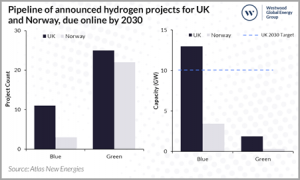Hydrogen’s “blue” variety scrubbed from oil and gas commands a 90:10 capacity lead over its electrolysed, cleaner “green” variant, in the UK and Norway, according to new analysis out this morning.
Aberdeen-based researchers Westwood Global Energy estimate that announced projects in hydrogen production scheduled for operation by 2030 amount to 16GW total capacity in western Europe’s two biggest oil-producing economies. Of that, 13 GW is located in the UK, researchers found, per the chart below.
That total means Britain is on track to shatter its 10GW ceiling in hydrogen production capacity, targeted by the government for the end of this decade.

By a ratio of four to one, numbers of pilots announced to make lower carbon “green” hydrogen surpass their blue, oil-derived cousins, according to the analysts.
But blue hydrogen projects already announced are on average far bigger than their green rivals, thanks to existing fossil fuel infrastructure, such as rigs and refineries already in place, plus downstream distribution networks and established customer relationships.
Economies of scale arising from the oil industry’s dominance dictate that, in Westwood’s judgement, oil-derived blue hydrogen will decide prices for the gas in all its variants, shaping the growth of hydrogen supply, the analysts predict. They will also determine the development & locations of imminent CCUS ( – carbon capture use and storage -) clusters.
David Linden, pictured, Westwood’s head of energy transition, observed: “Although considerable offshore wind projects are developing in Northwest Europe, hydrogen projects are emerging at an unrivalled pace.
“The scale of blue hydrogen developments makes them a necessity to ensure 2030 regional targets are met.
“In fact, the current pipeline of announced capacity for UK projects would exceed targets if all achieved their planned start-up dates.”
Linden continued: “This rate of change is representative of what we can expect as the energy transition gathers momentum. We are seeing increasing numbers of energy stakeholders diversifying their portfolios”.
Academics under Cornell professor Robert Howarth asserted last year that fossil fuel companies habitually understate blue hydrogen’s leakages of planet-heating gases when produced. The blue variant could be 20% more damaging to the climate over its product lifetime even than methane, their paper in the journal ‘Energy Science and Engineering’ calculated.
Chris Jackson, a key advisor on hydrogen to the Johnson administration, quit his post on the eve of the publication in August 2021 of the government’s Hydrogen Strategy.
Slamming blue hydrogen as an ‘expensive distraction’, Jackson, the boss of green hydrogen producer Protium, also stepped away from his post as chair of the UK Hydrogen and Fuel Cell Association.
Hydrogen’s spectrum of possibilities extends to “pink”, where power from nuclear generation performs the electrolysis.
Today’s research release is tied to Westwood’s launch of a new research product, Atlas New Energies. Based on a database of over 250 new energy projects in the UK and Norway, it provides interrogatable market intelligence linking existing and planned energy clusters, offshore wind, hydrogen, CCS and related oil and gas infrastructure in the UK and Norway.




